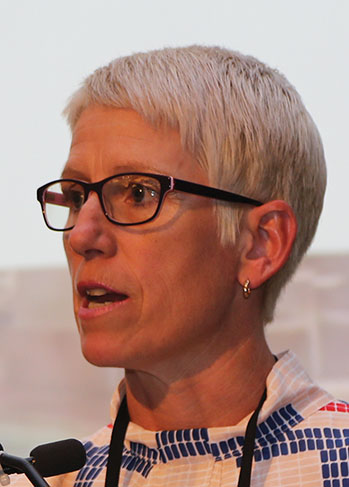Third Australian Veterinary Antimicrobial Stewardship Conference 2023
by Peter Bedwell
The third Australian Veterinary Antimicrobial Stewardship (AVAS) Conference was held at the Crowne Plaza, Surfers Paradise from November 20-22, 2023.
In the opening session, chaired by Jo Coombe, ‘Surveillance of usage and resistance – where should we be heading?’, the first speaker was Erda Rame Hau from the School of Veterinary Science, University of Queensland.
‘Integrated surveillance of antimicrobial resistance at the human, animal and environment interfaces: Critical appraisal of the evidence’ was her subject.
The background to Erda’s research was focused on “efforts to strengthen national and global AMR surveillance programs by integrating data across
human and animal sectors,” she said.
“Examples of truly integrated AMR surveillance remain relatively rare, and the WHO report ‘Antimicrobial Resistance: Global report on surveillance’ highlighted significant gaps in any surveillance.
“This review aims to examine the design characteristics of AMR integrated surveillance studies worldwide and critically appraise the surveillance design aspects that could partially explain correlations between AMR prevalence in each sector and the surveillance design,” Erda reported.
“The highest correlation in AMR prevalence between human/animal (HA) isolates was found in studies that targeted Campylobacter spp.
“Within all Campylobacter spp AMR studies, the highest AMR prevalence correlation was seen among studies that employed a case-based approach in the human sector,” Erda revealed.
“A case-based approach to surveillance has been noted to have advantages when compared to isolate or sample based designs, due to the availability of clinical data to supplement isolate information for risk factor analysis.
“In general, it can be concluded that the group of studies that employed a case base sampling design resulted in a higher correlation between H & A AMR compared to those with isolate based design,” she said.
Her conclusions were that “variation exists between studies with regards to the epidemiological and laboratory aspects of the survey design.
“The importance of approaching AMR surveillance designs needs to be addressed so as to be scaled globally to produced comparable data.”
Samantha Ellis (Department of Agriculture, Fisheries & Forestry, Canberra ACT) spoke about the ‘Increasing need for transparency around antimicrobial usage’.
She described the detailed Antimicrobial Usage Report that the APVMA submits and the annual reporting to the World Organisation for Animal Health (WOAH) which includes the overall amount sold for use/used in animals by antimicrobial class with the possibility to separate by type of use, (e.g. import/export, manufacturing).
Next, the overall amount sold for use/used in animals by antimicrobial class, with the option to seperate by type of use and animal groups, e.g. registration authorities, pharmacists, wholesalers, veterinarians.
“The annual reporting to WOAH is assisted through the use of a web based national portal that was launched in February 2023 which features easier reporting, error checks, data visualisation tools to facilitate analysis and communication,” Samantha explained.
“National concerns were recommendations from the JETACAR Report of 1999 (including the use of antibiotics in food producing animals) that a comprehensive monitoring and audit system for antibiotic usage that covered all areas of AB usage was needed.
Other concerns were that AMR had been detected in the food chain including media reports on superbugs found in beef and salmon.
On trade concerns, antimicrobial resistance had emerged during the UK free trade agreement and in negotiations with the EU.
“In the Australian context, considerations for AMU included extensive farming vs intensive farming; biosecurity including pre-border surveillance,
vaccination strategies and on-farm biosecurity practices,” she said.
“Important medicines for human health were never registered for use in food producing animals.
On the way forward, Samantha pointed to continual progress in strategies to reduce AMR .
“International messaging includes a continuation of detailed AMU to WOAH and consistent messaging around ‘appropriate use’ rather than just ‘reduced use’ and the process of educating global partners on the Australia’s context,” she explained.
“In the domestic scenario, national AMR surveillance activities show low levels of AMR (DAFF).
“There is national surveillance of antimicrobial resistant bacteria in retail food according to FSANZ surveillance.
“We have established prescribing guidelines and a vet collective.
“The One Health Surveillance sytem has create a sustainably funded national surveillance system that integrates human, animal, food and environmental usage and resistance data.
“Finally under the Objective 5 action plan, we are considering improvements in IT capability and data collection by going further down the production chain to include veterinary prescriptions and even individual animals,” Samantha concluded.
Dr Ian Jenson (First Management- Food Innovation Research) next addressed the topic of ‘Antibiotic Stewardship; resistance surveillance in a One Health context’.
“One Health is an integrated unifying approach that aims to sustainably balance and optimise the health of people, animals and ecosystems,” Dr Jensen said.
“It recognises the health of humans, domestic and wild animals and the
wider environment (including ecosystems) are closely linked and interdependent.
At the conclusion of the opening session on November 20, there was a panel discussion which allowed an active audience to question the session’s speakers.
Sky Badger spoke about transforming AMR and AMU surveillance: Integrating data from people, animals and the environment for better stewardship outcomes’.
“The aim is to develop a national AMU monitoring program for animals and identify AMU data sources to complement AM sales data; finally to identify IT platforms that can integrate vet and farm AMU data,” Skye said.
She explained the Fleming Fund Country Grant: AMR information system (AMRIS) that had conducted valuable research in Nigeria and Indonesia that had resulted in a secure Cloud-based electronic system being developed.
“The system integrates, manages, analyses and reports national level data from antimicrobial sensitivity testing, AMU and consumption data from humans, animals and the environment.
Skye next explained the AMRIS architecture that makes it such a
comprehensive data management system. She also explained operational features including the dashboard and on-line submission webforms that delivered easy and accuracy of on-line data submissions.
“What we learnt from our experience with AMRIS is, firstly, that a lot of time is spent with diverse stakeholders to identify needs and workflows.
“There is a need to make the information system beneficial for all data sharers and not to build a system that forces people to make big changes to their workflow.
“Flexibility and scalability to adapt to changing surveillance needs is critical and it is essential to build confidence in data sharing, governance and data security,” Skye emphasised.
Zoe Bartlett from Food Standards Australia and New Zealand next
explained the surveillance plan development as it applies to the national surveillance of antimicrobial bacteria in retail food.
“FSANZ is an Australia statutory body within the Australia government health portfolio and our main function is to develop and administer the Australia/New Zealand Food Standards Code.
“It has no responsibility for enforcement; FSANZ and other Australian and New Zealand government agencies continuously monitor the food supply to ensure it is safe,” Zoe explained.
“The objectives of the AMR surveillance project are to collect contemporary nationally representative phenotype resistance data for Salmonella, Campylobacter, E. coli and Enterococcus in prioritised retail meat commodities.
“Also to collect data to identify the emergence of AMR to high importance rated antimicrobials in these bacteria.
“Undertake Whole Genome Sequencing of bacteria displaying AMR phenotypes of interest (e.g. multidrug resistance to high importance related antimicrobials) and to identify known resistance determinants.
“Ensure that our data is scientifically robust, reliable, defensible, and comparable to international data and standards.
“Provide a foundational design according to international best practice, for future ongoing surveillance of resistant bacteria in food providing data that can be compared alongside integrated human, animal and environmental data collected as part of the ‘One Health’ approach,” Zoe said.
Next Zoe explained how the data outputs of the surveillance plan will contribute to exposure assessments for microbial risk assessment.
“Phenotypic resistance prevalence data will contribute to exposure assessments for microbiological risk assessment.
“Data that will allow for the analysis of trends for resistant bacteria and data that may contribute to future source-attribution.
“Data that can be compared alongside integrated human, animal, and environmental data collected s part of an Australia ‘One Health’ approach.
“Data that can contribute to informing policies, risk analysis, recommendations on antimicrobial usage in Australia, and facilitating trade,” Zoe explained.
At the official opening and start of Session 1, Dr Raymond Chia (AVAMS) welcomed delegates and acknowledged the contribution of Dr Kylie Hewson (CSIRO), who was in the Chair from the two previous AVAMS events.
“Australia has traditionally taken a cautious approach to the use of antimicrobials in animals, influenced by our nation’s clean and green reputation and the stance of the APVMA,” Dr Chia stated.
“For producers, the principals of antimicrobial stewardship have always been the guiding philosophy.
“With the escalating urgency of antimicrobial resistance (AMR), there is a greater potential to acknowledge ongoing endeavours and pinpoint areas necessitating further advancement.
“All industries bear the responsibility of curbing the emergence of AMR while upholding rigorous standards of animal health and well being,” Dr Chia said.
The first keynote speaker in Session 1 was Dr Mark Schipp, the retiring Chief Veterinary Officer of Australia.
Dr Schipp has been deeply involved with the problem of antimicrobial resistance and the appropriate usage of antimicrobials in livestock production, also the development of ‘One Health’ strategies.
Dr Schipp served as Agricultural Counselor in South Korea and China for six years before being appointed CVO in 2011.
He retired as CVO in late December 2023 and was replaced by Dr Beth Cookson who has more than 15 years experience in biosecurity policy and operations at DAFF.
In his presentation (his third at AVAMS) he traced the progress of action to deal with AMR and its potential consequences for human, animal health, and the environment.
“In 2011 a summit (ASID-ASA) was held at the University of Sydney and the Commonwealth interdepartmental JETACAR implementation group established.
“By 2013 an AMR Round Table and ‘One Health’ AMR colloquium was formed and in 2014 the Australian Strategic & Technical Advisory Group (ASTAG) continued progress on AMR strategies,” Dr Schipp reported.
“In 2017 a key progress report on the first AMR strategy was tabled leading to in 2018 the critical ‘Importance Ratings and Summary of antimicrobial use in human and animal health in Australia’.
“At a 2021 AMR Summit, a progress report was released on the first AMR strategy, involving CSIRO – Department of Agriculture, Water and the Environment DAWE- Department of Health (DoH)- Department of Industry, Science and Resources (DISER).
“Other critical steps have been the APVMA antimicrobial use (AMU) report in 2014 and the APVMA macrolide review in 2017 and finally the launch of the minimising AMR Mission in 2023,” Dr Schipp said.
“Today Australian livestock industries are fully engaged and active in AMR stewardship and supportive in antimicrobial prescribing guidelines.
“The Global Leaders Group (GLG) formed in 2020 has an independent global advisory and advocacy role with the primary object of maintaining urgency.
“The Muscat Manifesto issued at a high-level meeting on AMR in Oman in November 2020 with 40 countries signed up, recommended no use of medically important antimicrobials for non-veterinary purposes.
“On a global scale, a meeting to be held in New York in Sept 2024 intends to reaffirm global commitments to mitigate the threat of AMR and the need for appropriate funding to support those commitments which will be challenging.
“On future opportunities, an interim Centre for Disease Control will emerge in January 2024 moving to a full CDC in 2025.
In Session 2 (AVAMS The Big Picture) the first invited speaker was Cat McLaughlin, Head of Responsible Use of Medicines in Agriculture Alliance (RUMA) in the UK.
“RUMA agriculture is a not for profit cross sectoral alliance of 26 organisations representing supply chains from farm to fork across the UK.
“It provides leadership to the UK livestock industry encouraging innovative and proactive efforts to improve the responsible use of veterinary medicines while ensuring optimal animal health and welfare,” Cat explained in the introduction to her presentation.
Given the similarities between the UK and Australian poultry sectors, and the fact that Australian retail of both eggs and chicken meat are very much influenced by management with experience in the UK supermarket sector, we will publish a full report on Cat’s presentation and other important developments in recent antimicrobial research in the UK in the next edition of Poultry Digest.
Tireless advocate for AMR mitigation and the ‘One Health’ approach, Dr Kylie Hewson (CSIRO) spoke next; ‘The minimising antimicrobial mission – a coordinated One Health approach for addressing the risks of AMR in Australia’.
“AMR is something on everybody’s ‘to do’ list but, ‘I know I need to be doing something, but I’m not sure what’ is a typical response Kylie said in introducing her topic.
“The CSIRO’s Missions portfolio includes initiatives in:-
1. health and wellbeing, 2. food security and quality, 3. securing Australia and our region, resilient and valuable environments, 4. sustainable energy and resources, and 5. future industries.
“Securing a future where antimicrobials still save lives and build resilience to zoonotic infectious disease; growing export premiums of Australia grown food and helping to capture high-growth global protein markets are significant incentives to address AMR and implement a ‘One Health’ strategy,” Kylie said.
“AMR is a ‘One Health’ issue and in the Australian context it lacks definition but antimicrobials underpin our existing way of life, and are as such, a precious resource,” Kylie said.
“We need to convene partnerships across government, industry and community that allow for AMR mitigation actions to be prioritised and build communication that are consistent and effective to create change.
“Pay attention to policy and practice enablement thus creating an ‘ecosystem’ that enables and incentivises behavioural change where evidence and data informs policy.
“Sustainable ‘One Health’ financing is vital for AMR solutions.
“We have engaged the Deeble Institute (the research arm of Australian Healthcare and Hospitals Association (AHHA) to develop a business case for sustainable funding to undertake national priority actions and initiatives in animal health.
“Melbourne University’s Biointelect is developing a ‘One Health’ surveillance system that integrates AMR and AMU data from human health, animal health, agriculture, food and environment sectors in Australia.
“NovaViva, immunology specialists will identify and use antimicrobial alternatives and genetcs.
“Under development, are exercises in the definition of
appropriateness of use, an animal pathogen AMR surveillance framework and the extension, adoption and scale up to build capability.
“We are in the process of drafting data and information management, analysis and reporting needs, respecting sensibilities and this includes the determination of company level, sector/regional level (public and private) and national level reporting,” Kylie concluded.
In the years since the first AVAMS’ gathering, much progress has been achieved in tackling the problem of AMR both nationally and globally.
While the world has been distracted by both COVID, climate change and now on-going conflict in both Europe and the Middle East, there has been progress in meeting the challenges of AMR.
Global antimicrobial use in animals has dropped by 13% in the last three years according to a report published by the World Organisation for Animal Health (WOAH) in September 2023.
According to a report from New Scientist, AI has been used in the search to create a new class of antibiotic.
If trials are successful, it will be the first such discovery in over half a century.




